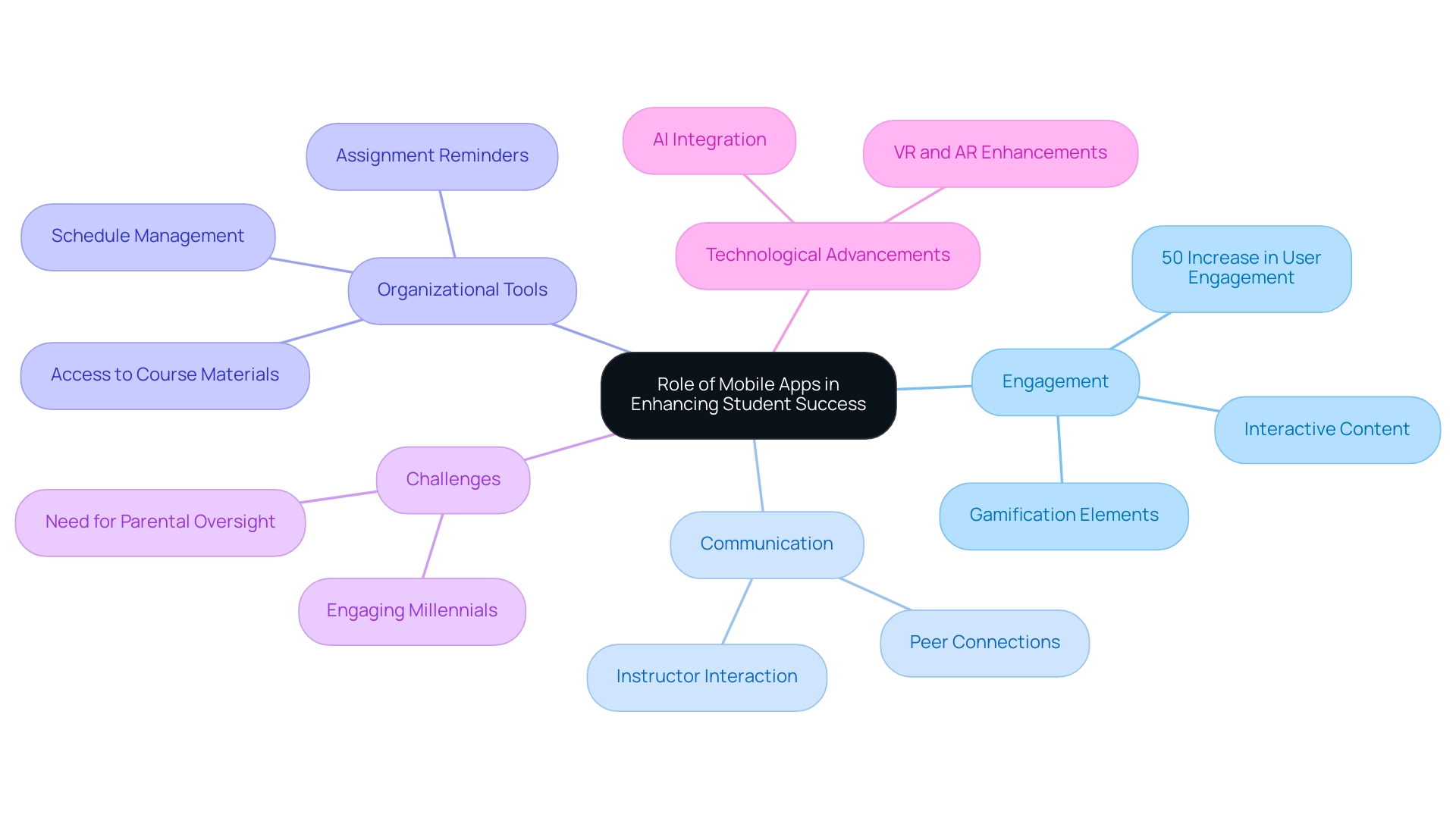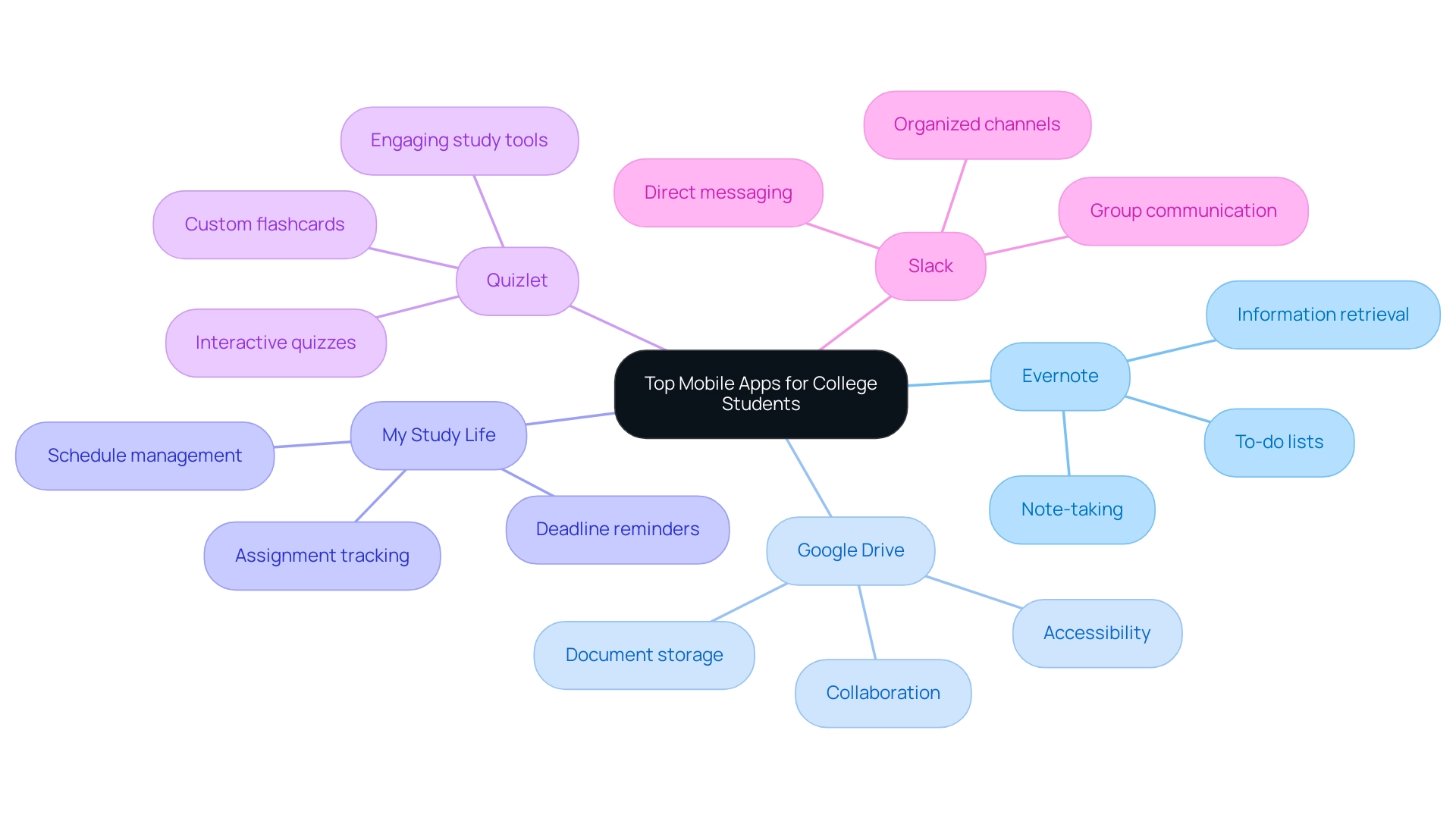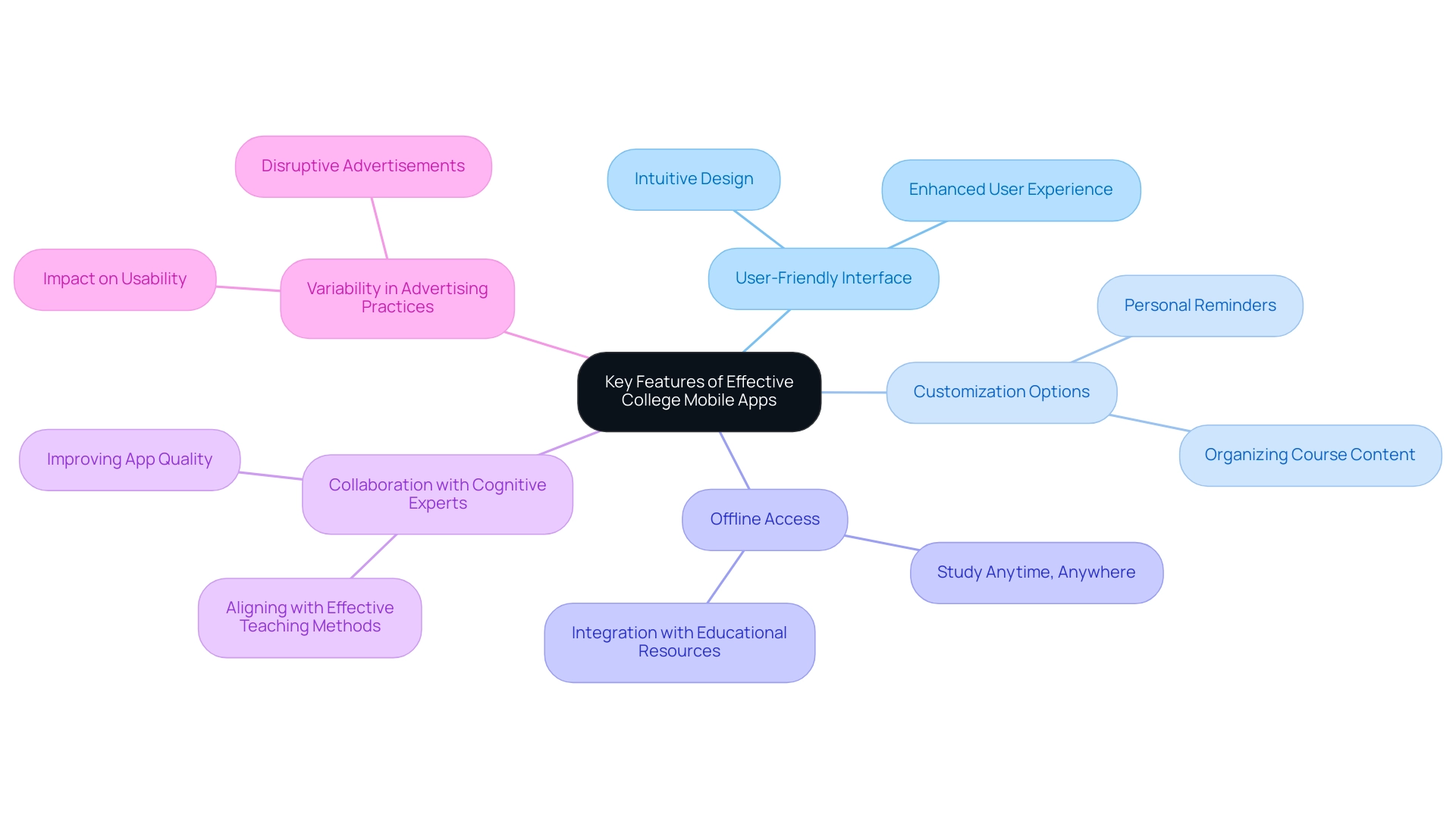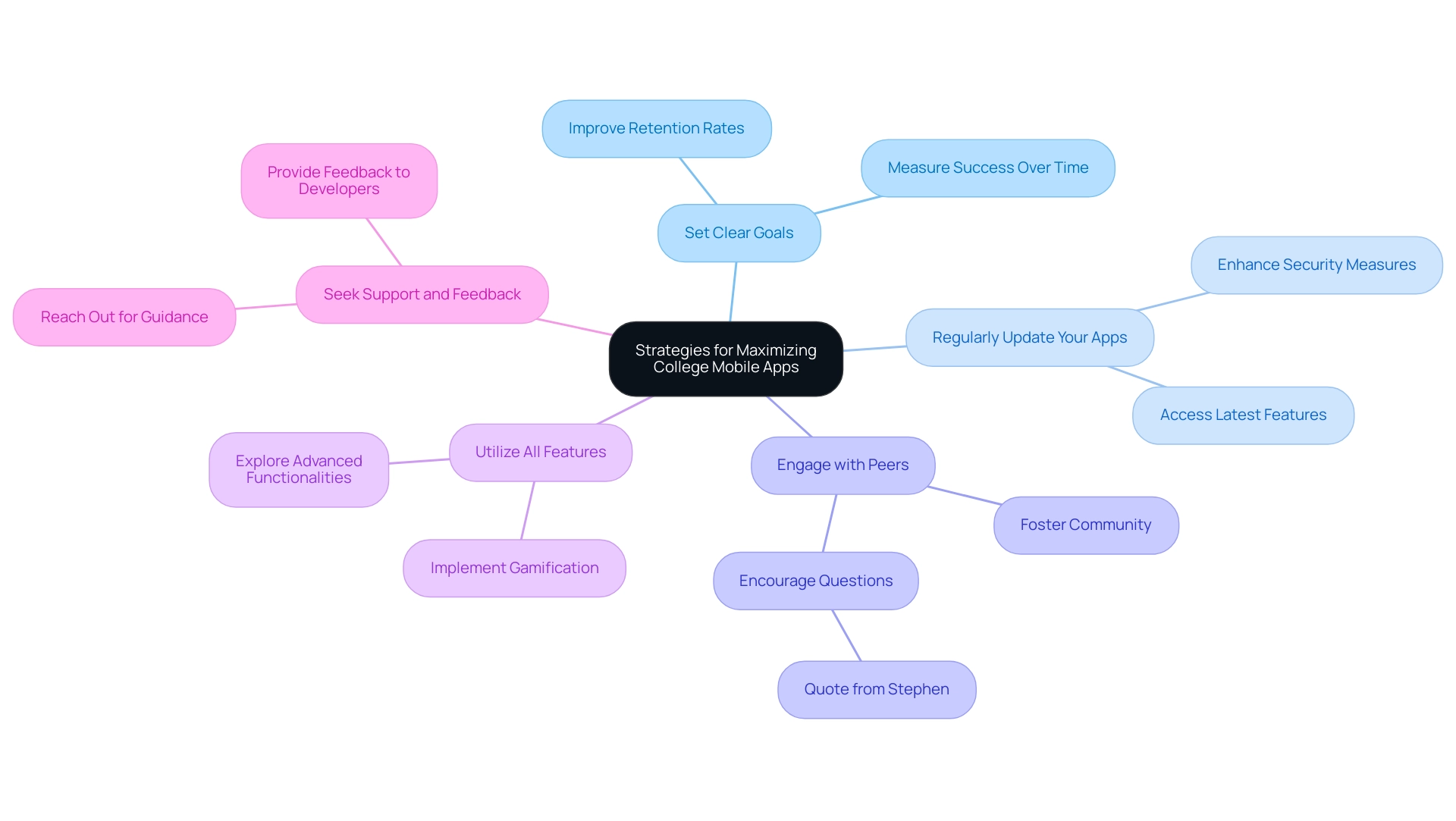Introduction
In an increasingly digital world, mobile applications are transforming the educational experience, providing students with unprecedented access to resources and fostering a more interactive learning environment. With an overwhelming majority of students dedicating their mobile time to apps, educational institutions are presented with both a challenge and an opportunity: to engage a generation that thrives on technology.
By harnessing the power of mobile apps, schools can not only enhance student success but also adapt to diverse learning styles through innovative features like gamification and personalized content.
This article delves into the pivotal role of mobile applications in education, highlighting:
- Essential tools every college student should consider
- Key features that make these apps effective
- Strategies for maximizing their use to ensure academic achievement
The Role of Mobile Apps in Enhancing Student Success
College mobile apps are transforming the learning environment by significantly boosting student achievement through streamlined access to resources, improved communication, and better organizational tools. Recent findings indicate that incorporating adaptive teaching principles can result in a remarkable 50% increase in user engagement within educational apps. This statistic highlights the potential of mobile technology to accommodate various educational styles and preferences.
As learners increasingly depend on their smartphones—91% of their mobile time is spent on apps—educational institutions face the challenge of engaging millennials, who are less involved than previous generations. By leveraging this trend, institutions can foster active learning experiences. By enabling learners to organize their schedules, access course materials, and connect with peers and instructors effortlessly, these applications become essential academic resources.
Features such as assignment and exam reminders in college mobile apps not only help students maintain awareness of their academic responsibilities but also cultivate a sense of accountability. Furthermore, interactive content, quizzes, and discussion forums embedded within these applications enable deeper engagement with study materials, ultimately leading to improved academic performance. The integration of advancements in AI, VR, and AR into these apps can further enhance educational experiences, making them more immersive and effective.
As Tynker aptly points out, it is crucial to balance the positive aspects of these educational tools with the need for parental oversight, ensuring that the technology serves as a constructive component of the educational experience. Additionally, the article 'Gamification: Is It Really That Great?' by Sasha Howard emphasizes the significance of involving learners through game-like elements, which can further motivate and enhance the learning process.

Top Mobile Apps Every College Student Should Consider
-
Evernote: This versatile note-taking application empowers users to effectively organize their lecture notes, create comprehensive to-do lists, and clip web articles for research purposes. With its robust tagging and search functionalities, Evernote enhances information retrieval, making it an indispensable tool for academic success. As noted by Eugenie Park, a Research Assistant, "The ability to organize and retrieve information quickly is crucial for learners in today's fast-paced educational environment."
-
Google Drive: Serving as a cornerstone for document storage and sharing, Google Drive excels in facilitating collaboration on group projects. Students can easily access files from any device, ensuring seamless teamwork and efficient project management. Its integration with other Google services further amplifies its utility in academic settings. The significant rise in education app usage during the pandemic, from 388 million to 550 million, illustrates how essential tools like Google Drive have become for collaboration among learners.
-
My Study Life: A vital planner application, My Study Life assists learners in managing their schedules by tracking assignments and setting reminders for crucial deadlines. This tool not only aids in time management but also assists individuals in maintaining a balanced workload, ultimately enhancing their academic performance. According to recent studies, effective time management apps have seen improved retention rates, indicating their growing importance among learners.
-
Quizlet: As a robust study aid, Quizlet enables learners to create custom flashcards and quizzes, streamlining the memorization of key concepts. Its interactive learning tools cater to various learning styles, making study sessions more engaging and effective. The app's retention rates indicate that users find value in its features, further supporting its recommendation.
-
Slack: Ideal for fostering group communication, Slack provides a platform for individuals to collaborate on projects through organized channels and direct messaging. This application keeps all discussions centralized, enhancing productivity and ensuring that project details are easily accessible.
The heightened dependence on college mobile apps among learners is clear, particularly as the usage of educational applications escalated from 388 million to 550 million during the pandemic. With 19% of U.S. adults in urban areas relying on smartphones, the significance of these applications in enhancing student productivity cannot be overstated. The case study titled 'Education App Users' highlights how this surge in usage has led to increased user engagement, further emphasizing the role of mobile apps in modern education.

Key Features of Effective College Mobile Apps
When evaluating mobile applications for colleges and universities, several key features stand out as essential for enhancing the educational experience:
- User-Friendly Interface: An intuitive design is paramount. A seamless interface in college mobile apps that allows for easy navigation and quick access to essential tools significantly enhances the user experience, fostering higher satisfaction ratings among learners. Studies indicate that the mean effect size for combining online and in-person education is +0.35, p < .001, underscoring the importance of user-friendly design in educational apps.
- Customization Options: Tailoring the app to meet individual needs, such as setting personal reminders or organizing course content, is crucial for maximizing its effectiveness. Customization through college mobile apps empowers learners to engage with the material in ways that suit their unique learning styles.
- Offline Access: The capability of college mobile apps to access materials without an internet connection ensures that learners can study anytime, anywhere, making education more accessible. This flexibility is particularly vital in environments with unreliable connectivity, especially for college mobile apps. Successful college mobile apps often integrate seamlessly with platforms like Google Calendar and various educational resources, streamlining workflows and improving productivity. This integration of college mobile apps assists learners in managing their schedules and coursework more effectively. Incorporating engagement features like gamification elements, quizzes, and interactive content in college mobile apps can significantly enhance student engagement and motivation. These features not only make education more enjoyable through college mobile apps but also cater to diverse preferences for acquiring knowledge. As pointed out by Isidora Markovic, contemporary mobile-first training tools mirror the smooth experiences seen in popular platforms like Instagram, employing formats such as stories to connect with users.
- Collaboration with Cognitive Experts: The need for collaboration between the app industry and cognitive experts is critical to improving app quality. This collaboration can guarantee that instructional software corresponds with efficient teaching methods, tackling the difficulties encountered in software development.
- Variability in Advertising Practices: It's important to recognize that variability in advertising practices can affect the coding of applications, impacting their usability and effectiveness. By concentrating on these key features and tackling the challenges within the sector, institutions can develop college mobile apps that not only meet but surpass user expectations, ultimately promoting a more effective learning environment.

Strategies for Maximizing the Use of College Mobile Apps
To maximize the effectiveness of college mobile apps, it is essential to implement several strategic approaches:
-
Set Clear Goals: Establish specific objectives for each app you use, whether that entails improving academic performance, enhancing organization, or fostering collaboration among peers. Setting goals not only provides direction but also aids in measuring success over time. Importantly, clear goal setting can help combat the alarming retention rates observed in educational applications, where Day 1 retention is at 18%, dropping to 8% by Day 7, and only 4% by Day 30.
-
Regularly Update Your Apps: Keep your applications current by updating them regularly. This practice ensures access to the latest features, optimal functionality, and enhanced security measures, which are crucial for a seamless user experience.
-
Engage with Peers: Foster a sense of community by encouraging classmates to adopt the same mobile apps. As Stephen noted, "Lecturers have to make learners feel secure in that they can easily ask questions regarding concepts that they do not understand." This cooperative method not only improves educational experiences but also establishes a support network where individuals can share insights and strategies.
-
Utilize All Features: Take the initiative to explore the full range of functionalities that each app offers. Numerous learning applications incorporate advanced features that can substantially improve the learning process, beyond their basic functions. The case study titled "User Retention Challenges" highlights that the decline in retention rates emphasizes the need for strategies like gamification to keep learners engaged.
-
Seek Support and Feedback: Don’t hesitate to reach out to peers or instructors for guidance on maximizing app usage. Additionally, providing constructive feedback to app developers can lead to improvements in future updates, ensuring that the tools remain effective and user-friendly.
By adopting these strategies, educators can better support students in their engagement with educational apps, ultimately leading to improved retention and academic success.

Conclusion
Mobile applications are transforming education by significantly enhancing student success. By providing improved access to resources, communication, and organizational tools, these apps cater to diverse learning styles and preferences. As reliance on smartphones grows, educational institutions can leverage this trend to foster more interactive learning environments.
Key applications such as:
- Evernote for note-taking
- Google Drive for collaboration
- My Study Life for time management
empower students to stay organized and connected, ultimately boosting academic performance. Effective educational apps feature user-friendly interfaces, customization options, offline access, and engaging elements that maximize their impact on learning.
To fully capitalize on mobile applications, students and institutions should implement strategic approaches. These include:
- Setting clear goals
- Regularly updating apps
- Promoting peer engagement
These are essential for enhancing the educational experience. Exploring all available features can further deepen learning and retention.
In summary, the role of mobile applications in education is crucial. By embracing these tools, educational institutions can create engaging environments that not only support student success but also prepare learners for a technology-driven future. The opportunity to maximize the potential of mobile technology in education is now, ensuring that every student has the resources needed to excel academically.





